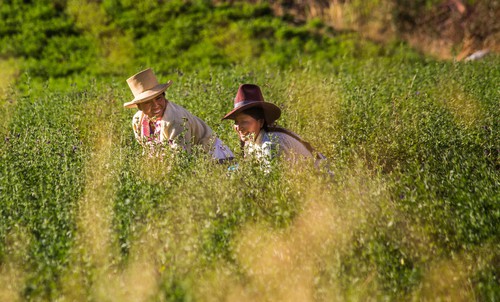Women farmers across the world play an important role in the conservation and care of crop diversity. The maintenance of crop diversity is central to food security, nutritional diversity, health, and cultural traditions for rural communities globally. In the Andean highlands, smallholder women farmers use local knowledge and skills transmitted through generations to select and conserve seeds of traditional crop varieties. Andean women farmers protect biodiversity through their seed saving practices, sustainable agricultural practices, and unique culinary uses of different crops.
The importance of biological diversity and crop genetic resources is fundamental to sustainable agricultural production, yet biodiversity loss is quickly accelerating due to factors such as social, agricultural, and cultural change. The Global Biodiversity Outlook 4, a recent report by the United Nations Convention on Biological Diversity states that the “wild relatives of domestic crop species are increasingly threatened by habitat fragmentation and climate change.” In addition, factors impacting the loss of crop diversity include land use changes, off-farm migration, market integration, cultural change, and population reduction in rural communities. In the presence of the growing loss of agrobiodiversity, women farmers’ conservation efforts on farm (in situ) are essential.
The Andes are home to incredible biodiversity where farmers have selected countless varieties of native crops—such as quinoa, maize, potatoes, oca, olluco, and mashua—adapted to heterogeneous environments with varied climates, soils, geography, and altitude. For instance, although often portrayed as a superfood with vast nutritional properties, most people only consume a few commercial varieties of quinoa, and are unaware of the hundreds of quinoa landraces of different sizes, colors, flavors, and textures selected by indigenous farmers.
Women farmers perform much of the family farm work and participate in the entire agricultural cycle, with particular attention to post-harvest and food preparation activities. The women use different criteria for harvested produce, and they manage and divide these according to their family needs. For example, when women separate and classify the potatoes, they categorize which potatoes will be used for seed, for immediate meals, for storage, and for processed foods.
The case study “Women Farmers and Andean Seeds” documents how Andean women in Peru use their traditional knowledge and skills to select and conserve biodiversity. In addition to caring for their fields, women farmers in the Andes also have homegardens, where they grow a vast variety of indigenous crops. The report highlights the contributions of conservationist women known in their communities for their experience in and dedication to conserving seeds. Selection criteria that women farmers take into account include yield, consistency, and the flavor of the variety. One of the women featured in this report is Doña Meshe, who explains her techniques for selecting the potatoes: “Potato seed has to be very nice and healthy. Therefore we take care that it is: free of blight and diseases, without damage from worms or nematodes, and without damage or cuts from the harvest.”
Anthropological research in different areas of the world has found that farmers also value and maintain traditional varieties for complex reasons such as: risk management; agro-ecological adaptation; yield size; quality (taste and flavors); economic value; cultural memory; cultural identity; and cultural salience. In fact, a recent study by anthropologist Kristine Skarbø, a postdoctoral fellow at Norwegian University of Life Sciences, documents that culture, particularly local food traditions, and subsistence are key to fostering diversity maintenance.
Through their cultural knowledge and agricultural practices, women farmers in the Andes are guardians of crop diversity, and contribute to food security for their families and local communities.













